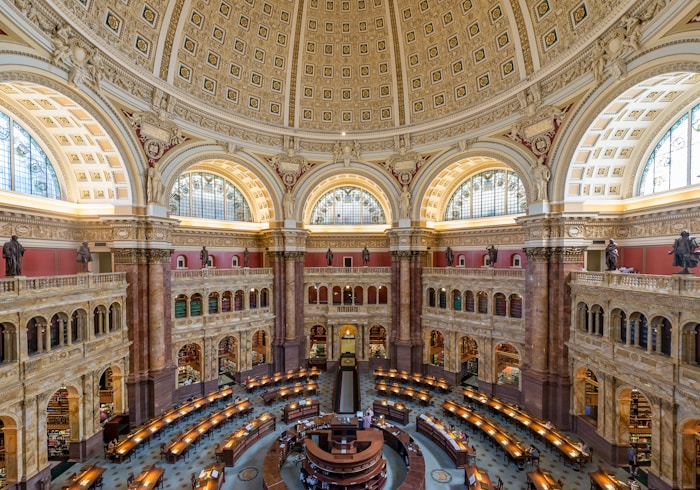
How Many Books is Too Many? Ask the World’s 10 Biggest Libraries
There are 22 libraries in the world that have a whopping 15 million items catalogued. The upper limit, though, is over ten times that amount. Here are ten of the world’s biggest – with a few facts thrown in too.
Note: this does not include privately owned libraries. There is some debate about exactly which libraries are the biggest, but these are the numbers I think are truest.
10 Biggest Libraries in the World
#1. The British Library, United Kingdom
I’m proud to announce that, despite having a budget that’s only about a third of the Library of Congress, the British Library clocks in as the world’s biggest library. It has between 170 million and 200 million items, squeezed onto 388 miles of shelves. The main seat of the library is in London (near the world-famous King’s Cross Station) but there’s also a runoff in Boston Spa. They receive 8000 new titles per day, so that runoff is badly needed.
The British Library was technically founded in 1973, but before that most of its collections were part of the British Museum. Visiting can admittedly be a bit of a hassle. On one farcical occasion, I had to take the lift between the basement and third floor a good three or four times, because I kept forgetting various items down in my basement locker – such as my phone, wallet, and the card I needed to get past the guards. Once you’ve actually made it into the Reading Room, though, it’s a quiet and pretty place to work.

Photo by Stephen Walker on Unsplash
#2. Library of Congress, United States
This one looks absolutely majestic – I can’t wait to visit!
The Library of Congress in Washington, D.C., has around 170 million items, and is America’s national library. It was first founded in 1800, but the British destroyed most of the original collection in 1814 (during…the War of 1812). It got back on its feet and bought Thomas Jefferson’s own private library of over 6000 books. Then more bad luck struck in 1851, and a fire put paid to most of the collection. Since the American Civil War, it’s managed to grow rapidly. The nearly $700 million annual budget doesn’t hurt.
Unlike the British Library, which is available for absolutely everyone and has no official mission beyond that, the Library of Congress technically exists mainly for Congressional inquiries.
#3. Shanghai Library, China
At 56 million items, China’s Shanghai library actually beats out the National Library of China. A part of it, the Bibliotheca Zi-Ka-Wei, was founded in 1847 by European Jesuit missionaries; the Shanghai Municipal Library, built in 1952, later absorbed the Bibliotheca.
It’s also one of the biggest libraries physically, as a 348 foot tower makes it the world’s second tallest library. Unfortunately, data on its budget or visitor numbers are not available.

Photo by Clay Banks on Unsplash
#4. New York Public Library, United States
The New York Public Library edges in at fourth place with 55 million items. It actually consists of 92 locations around the state, which is part of why it’s so big. The main building, the one that probably comes to mind when you think of the NYPL, is in Manhattan. I got to visit it a few years ago and the inside is just as gorgeous as the outside!
The NYPL was established in 1895 and has an annual budget of around $3 million. It was basically the Google of America before Google came along. Here are some really funny questions people rang up to ask the librarians in the 20th century.
#5. Library and Archives Canada, Canada
The Library and Archives Canada (LAC) is, none of you will be be shocked to hear, in Canada (specifically Ottawa). This incarnation was created in 2004, but before that it was the National Archives of Canada, which has a history – under various names – dating back to 1872. The 2004 Act merged the NAC with the National Library of Canada, founded in 1952.
The LAC has 54 million items. Perhaps a little oddly, genealogists constitute 70% of the patrons. The total budget comes to around $86 million, although it has only a third of the staff members as the preceding libraries on this list.
#6. Russian State Library, Russia
Moscow hosts the Russian State Library, which opened first in 1862 and contains 47 million items on 275 km of shelves. In 1925 the Bolsheviks renamed it the catchy V.I. Lenin State Library of the USSR, but in 1992 President Boris Yeltsin gave it the name it bears today.
The Library’s annual budget is over $33 million, but it has the lowest visitor numbers of any library on this list so far. Less than a million people visit per year, compared to two million for the British Library and Library of Congress – and a huge 18 million visitors for the NYPL.
The website seems to be a bit misleading: it claims to be the ‘second largest library in the world’, which is definitely not true. It is certainly the biggest library in Russia, though.
#7. Royal Danish Library, Denmark
Like the British Library, the Royal Danish Library spreads out over two main locations – Copenhagen and Aarhus, the country’s second largest city. This is because of a 2017 merger between two separate institutions. Those in turn consist of different mergers. Bear with me while I try to get this all straight…
So, one of the constituent elements of the Royal Danish Library is the Royal Library in Copenhagen, which is the university library for the University of Copenhagen. It was built in 1648 as a different public library, and in 1989 it absorbed the Copenhagen University Library, established in 1482. This composite Royal Library then incorporated the State and University Library (SUL) in Aarhus, the university library for Aarhus University. The SUL opened in 1902.
Together, the two subsidiaries of the Royal Danish Library have 43 million items. The combined budget comes to $79 million per year.
#8. National Diet Library, Japan
Like the Library of Congress, Japan’s National Diet Library is there to assist members of the legislative body in their enquiries. The two main branches in Tokyo and Kyoto have 42 million items.
The original version of the NDL is the Imperial Library of 1872. In 1890, it was superseded by the two parliamentary libraries of the Imperial Diet. This current incarnation dates back to 1948. Of the world’s top ten biggest libraries, the NDL has the lowest visitor numbers: only 650,000 people come per year. At $205 million, though, the budget is definitely not small.
#9. Bibliothèque Nationale de France, France
The Bibliothèque Nationale de France can claim a history dating all the way back to 1368, when Charles V founded a royal library at the Louvre Palace. That collection was ultimately lost, but Louis XI began another one in 1461. This grew and became open to the public in 1692. Thanks to a couple of librarians and scholars, the books suffered no losses during the French Revolution. In fact, the opposite happened; the libraries of executed aristocrats were added to its catalogues. In 1896, it was the biggest library in the world.
Other libraries have since overtaken the BNF, of course, but it still has a respectable 40 million items. Also, at $288 million/year, a more than respectable budget.
#10. National Library of China, China
The second Chinese library on this list! With 37 million items, it’s ranked tenth of the biggest libraries in the world. It has a majestic history as the Imperial Library of Peking – which it was called when it first opened in 1912. After that, it underwent several name changes until it reached its current status.
Reportedly, the Library receives 5 million visitors per year; however, budget figures are unknown.
These libraries all have rare and valuable collections. Mostly, you can’t take the items out. But here are 18 weird things you can borrow from your local library.

















